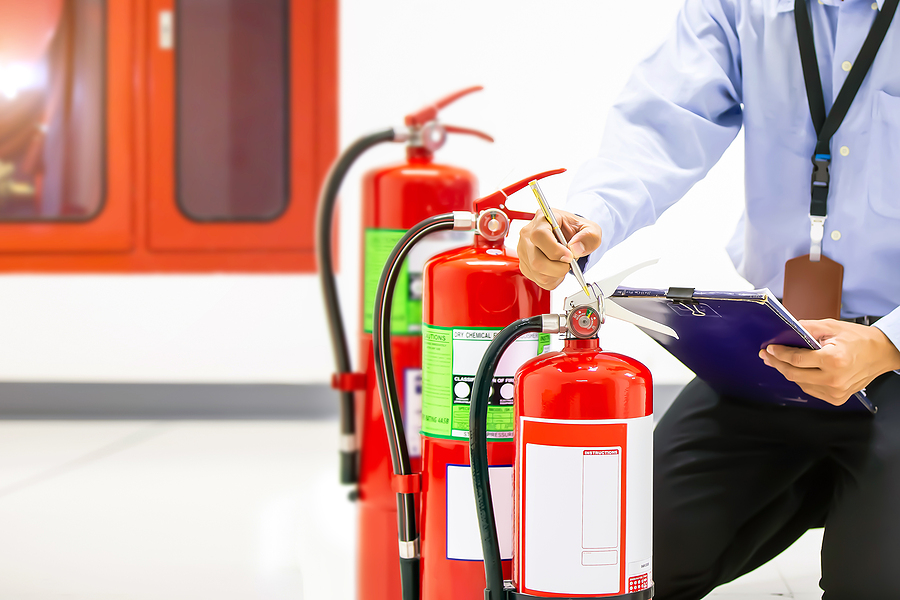According to the Occupational Safety and Health Administration (OSHA), the most prevalent type of emergency that small businesses plan for is a fire. In the case of a more significant fire, a fire extinguisher may be utilized to either put out little flames in the workplace or defend exit routes in the event of a more substantial fire. Both applications are useful. OSHA mandates that employers provide their employees with thorough training in the correct way to use an extinguisher and the right way to accurately assess a situation and determine when it is safest to evacuate the building. This training must include the proper use of an extinguisher and the appropriate way to determine when it is safest to evacuate. At the very least, every year, OSHA mandates that workers get training in the proper operation of fire extinguishers.
Extinguishers are devices used to put out fires. An appliance device intended to be easily moved or capable of doing so and that contains or produces any liquid, powder, or gas used to extinguish a fire is referred to as a fire extinguisher. This definition was developed by the National Fire Protection Association (NFPA). The fact that there are several distinct kinds of fire extinguishers is something that many people are unaware of.
Types of Fire Extinguishers:
There are many different types of fire extinguishers available on the market today. These fire extinguishers put out fires using various extinguishing media, including water, carbon dioxide (CO2), dry chemicals, and wet chemicals. Knowing that the kind of fire you are fighting dictates the extinguishing medium you should employ is essential. The following chart classifies different types of fires according to the fuel they use:
The classifications of fires that the extinguishers are designed to fight are printed on their labels. Class ABC fire extinguishers are the ones you are most likely to see in use in commercial and industrial settings. Extinguishers with a Class ABC rating are designed to successfully put out flames in which the primary fuel source is either ordinary combustibles, flammable liquids, or live electrical equipment. Dry chemical is the most frequent extinguishing medium in Class ABC extinguishers. Class K and Class D fire extinguishers are two other typical classifications. The wet chemical is what Class K extinguishers use, and you can typically find them in kitchens and other places where oils and grease are frequently used as cooking ingredients. Lastly, extinguishers of the Class D variety discharge dry powder and are typically located where combustible metals are used or stored.
The PASS method is an accessible fire extinguisher training methodology that may be used with employees for Class ABC and K extinguishers. It consists of the following steps:
- To light the candle, pull the pin and stand eight or ten feet away from the blaze.
- Aim the embers near the fire’s foundation.
- Put some pressure on the handle.
- Move in a circular motion around the base of the fire while blasting the extinguishing chemical out.
Additional helpful hints include the following:
- When shooting at the flames, aim low. Then, you will need to find a way to put out the fire using that method successfully.
- Keep in mind that most fire extinguishers have a minimal amount of time to use, usually between 8 and 10 seconds. Because of this, you need to move swiftly and spray the extinguisher towards the base of the fire rather than the smoke or the flames.
- Extinguishing a Fire using a Class D Fire Extinguisher:
- Take out the tack
- Always keep the fire extinguisher in an upright position.
- Hold the nozzle above the fire. Because of the length of the extension applicator hose and the squeeze grip valve, it is possible to position the dry powder precisely where it will have the most significant impact.
- Squeeze the discharge lever. Apply pressure gradually and uniformly. Because of this action, the dry chemical will be released. Use the dry powder to coat the flaming metal with a layer of powder thoroughly, then apply the powder as needed.
After you have gained control of the situation, you should move into a position within close range. Next, spread a thick powder coating over the metal and cover it completely. Be extremely careful not to crack the crust that the powder has created. Next, open up the extinguisher’s nozzle in a measured fashion.
- When it comes to fire extinguishers, these are some of the ways that Brazas Fire may assist your company:
- You were advising on the kind of portable fire extinguishers available onsite concerning the processes you have going on there.
- To ensure the safety of your company’s employees and customers, you should provide the fire extinguishers required to be kept on the premises. Performing checks of the fire extinguisher every month.
- To book an appointment, please get in touch with Brazas Fire as soon as possible at 505-889-8999.
